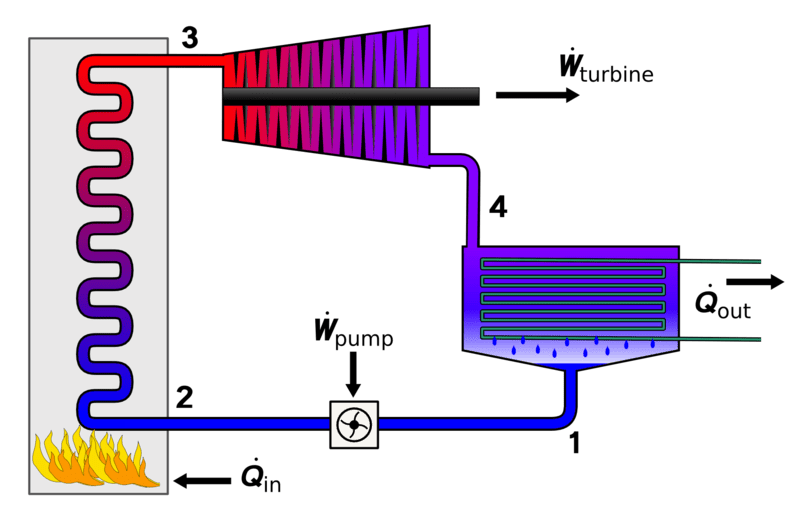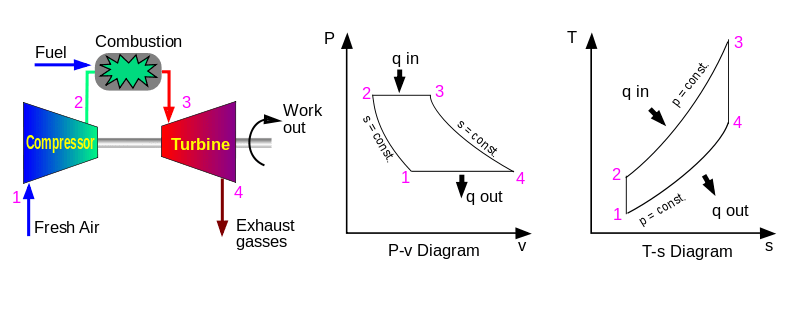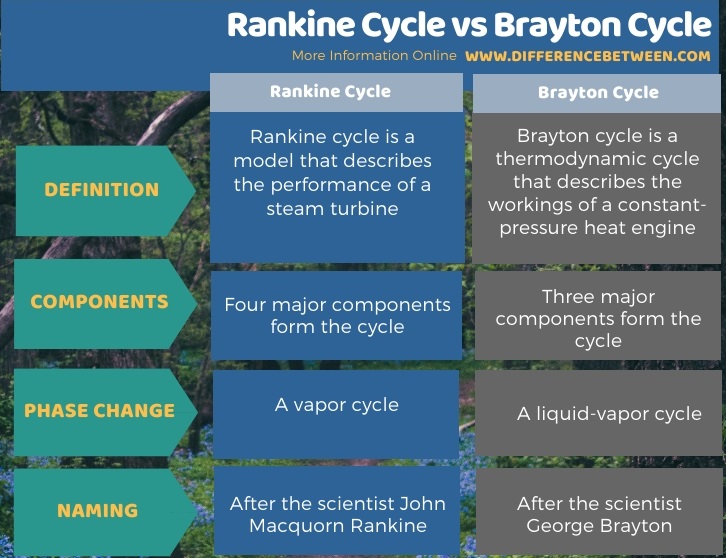Difference Between Rankine Cycle and Brayton Cycle
Table of Contents
The key difference between Rankine cycle and Brayton cycle is that the Rankine cycle is a vapour cycle, whereas the Brayton cycle is a cycle between liquid and vapour phases.
Both the Rankine cycle and Brayton cycle are thermodynamic cycles. A thermodynamic cycle is a sequence of different thermodynamic processes that involve the transfer of work and heat in and out of a system, which has variable temperature and pressure conditions.
CONTENTS
1. Overview and Key Difference
2. What is Brayton Cycle
3. What is Rankine Cycle
4. Side by Side Comparison – Rankine Cycle vs Brayton Cycle in Tabular Form
5. Summary
What is Rankine Cycle?
Rankine cycle is a model that predicts the performance of a steam turbine. The model is a vapour cycle. It is an ideal model for the thermodynamic cycle that takes place in a heat engine with a phase change. There are four major components in the Rankine cycle and we can neglect the friction losses from any of these four components.

Figure 01: Rankine Cycle
The theory behind the Rankine cycle is used in thermal power generation plants to generate power. The power generated through this process depends on the temperature difference between the heat source and cold source. If the difference is considerably high, then we can extract more power out of heat energy. Usually, the heat source used here can be either nuclear fission or burning fossil fuels. Higher the temperature, better the source is. Meanwhile, cold sources include cooling towers with a target water body. Cooler the temperature, better the source is. The four phases in the Rankine cycle are as follows:
What is Brayton Cycle?
Brayton cycle is a thermodynamic cycle that describes the workings of a constant-pressure heat engine. The cycle usually runs as an open system. But, for the requirements of thermodynamic analysis, we consider it as a closed system operation by assuming that exhaust gases are reused during the process. The process was named after the scientist George Brayton. The idealized model for the Brayton cycle is as follows:

Figure 02: Brayton Cycle
The cycle contains three components. They are the compressor, mixing chamber and expander. Brayton engines are usually in the turbine engine type.
What is the Difference Between Rankine Cycle and Brayton Cycle?
Rankine cycle is a model that describes the performance of a steam turbine, while Brayton cycle is a thermodynamic cycle that describes the workings of a constant-pressure heat engine. The key difference between Rankine cycle and Brayton cycle is that the Rankine cycle is a vapour cycle, whereas the Brayton cycle is a cycle between liquid and vapour phases. Besides, another difference between Rankine cycle and Brayton cycle is that there are four components in the Rankine cycle while there are only three components in the Brayton cycle.
The below infographic tabulates the difference between Rankine cycle and Brayton cycle.
 Summary – Rankine Cycle vs Brayton Cycle
Summary – Rankine Cycle vs Brayton Cycle
Both Rankine cycle and Brayton cycle are types of thermodynamic cycles. The key difference between Rankine cycle and Brayton cycle is that the Rankine cycle is a vapour cycle, whereas the Brayton cycle is a cycle between liquid and vapour phases.
Reference:
1. “Rankine Cycle.” Wikipedia, Wikimedia Foundation, 17 Jan. 2020, Available here.
Image Courtesy:
1. By Wikipedia (user:andrew.ainsworth) user [[:User:Andrew.Ainsworth:User:{{{3}}}|{{{3}}}]] (CC BY-SA 3.0) via Commons Wikimedia
2. “Brayton cycle” (CC BY-SA 3.0) via Commons Wikimedia
ncG1vNJzZmivp6x7pbXFn5yrnZ6YsqOx07CcnqZemLyue8OinZ%2Bdopq7pLGMm5ytr5Wau26%2BwKeioqaVYrC6r8ueZJqmlGKvs63YraanZZOusK2xjg%3D%3D